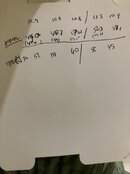You are using an out of date browser. It may not display this or other websites correctly.
You should upgrade or use an alternative browser.
You should upgrade or use an alternative browser.
Cell linearity
- Thread starter Bob523
- Start date
Please register or login
Welcome to ScubaBoard, the world's largest scuba diving community. Registration is not required to read the forums, but we encourage you to join. Joining has its benefits and enables you to participate in the discussions.
Benefits of registering include
- Ability to post and comment on topics and discussions.
- A Free photo gallery to share your dive photos with the world.
- You can make this box go away
- Messages
- 14,158
- Reaction score
- 11,367
- Location
- Port Orchard, Washington State
- # of dives
- 1000 - 2499
can't read your handwriting, you should be getting 95%+ of predicted.Two of my cells are 12 months old. Would everyone agree these cells are still linear?
They were 3% drift on 100% at surface level. I spiked the cells to look at the mV at 20ft - they weren’t current limited. Came up to 80s and 90s respectively…..stayed within 3-4% drift. I dove them and kept the P02 low at 1.0 just in case for margin of error.can't read your handwriting, you should be getting 95%+ of predicted.
Thanks for the quick response
that's lovely - now replace them and suffer like the rest of usTwo of my cells are 12 months old. Would everyone agree these cells are still linear?

justinthedeeps
Contributor
Is this for rEvo? I thought the common practice was to just replace the oldest cell every six months, and then also any cell that is doing anything iffy?
justinthedeeps
Contributor
Here's a question for thought:
If the mV reading is 5% lower on 100% O2 than its linear multiple from 21% (x4.76), but you still calibrate properly on 100% oxygen, then how far off from proper deco and CNS are you for a dive where ppO2 is set at 1.0-1.3 atm?
I think the answer is your deco and CNS error are going to be significantly less than 5% off, because calibrating at 1.0 atm means you are still very close to correct at this range. The minor curve back down to ~8-12 mV isn't where you are operating the unit.
Minimum/maximum mV limits, lifetime, and cell responsiveness probably matter more than linearity itself. Surface linearity test is good, but dil and O2 flushes for low and high cell check at relevant depths more operationally relevant.
Bonus question:
Is it bad for galvanic cells to run them up to 3 atm of oxygen in a pressurized cell checker? Does this risk pushing the chemistry too hard? Or shorten lifespan? Or is it good to force failure on a cell this way so that you know it's bad sooner?
If the mV reading is 5% lower on 100% O2 than its linear multiple from 21% (x4.76), but you still calibrate properly on 100% oxygen, then how far off from proper deco and CNS are you for a dive where ppO2 is set at 1.0-1.3 atm?
I think the answer is your deco and CNS error are going to be significantly less than 5% off, because calibrating at 1.0 atm means you are still very close to correct at this range. The minor curve back down to ~8-12 mV isn't where you are operating the unit.
Minimum/maximum mV limits, lifetime, and cell responsiveness probably matter more than linearity itself. Surface linearity test is good, but dil and O2 flushes for low and high cell check at relevant depths more operationally relevant.
Bonus question:
Is it bad for galvanic cells to run them up to 3 atm of oxygen in a pressurized cell checker? Does this risk pushing the chemistry too hard? Or shorten lifespan? Or is it good to force failure on a cell this way so that you know it's bad sooner?
mr_v
Contributor
If my PPO reads ~1.6 at 20' and cells respond quickly, then they're good.
I used to do all sorts of calculations - it was a good exercise but it consumed time that I could spend on other things. I track mV in air - any abrupt change forces a closer examination.
I used to do all sorts of calculations - it was a good exercise but it consumed time that I could spend on other things. I track mV in air - any abrupt change forces a closer examination.
Similar threads
- Replies
- 10
- Views
- 825
- Replies
- 12
- Views
- 902
- Replies
- 0
- Views
- 349




